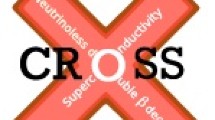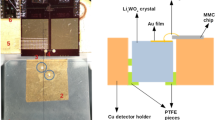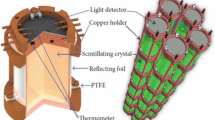Abstract
Neutrinoless double-beta (\(0\nu \beta \beta\)) decay is a hypothetical rare nuclear transition (\(T_{1/2}>10^{25}\)–\(10^{26}\) year). Its observation would provide an important insight into the nature of neutrinos (Dirac or Majorana particle) demonstrating that the lepton number is not conserved. This decay can be investigated with bolometers embedding the double-beta decay isotope (\(^{76}\mathrm{Ge}\), \(^{82}\mathrm{Se}\), \(^{100}\mathrm{Mo}\), \(^{116}\mathrm{Cd}\), \(^{130}\mathrm{Te}\)...), which perform as low-temperature calorimeters (few tens of mK) detecting particle interactions via a small temperature rise read out by a dedicated thermometer. Cryogenic Rare-event Observatory with Surface Sensitivity (CROSS) aims at the development of bolometric detectors (based on \(\hbox {Li}_{{2}}\hbox {MoO}_{{4}}\) and \(\hbox {TeO}_{{2}}\) crystals) capable of discriminating surface \(\alpha\) and \(\beta\) interactions by exploiting superconducting properties of Al film deposited on the detector surface. We report in this paper the results of tests on prototypes performed at CSNSM (Orsay, France) that showed the capability of a-few-\(\upmu \mathrm{m}\)-thick superconducting Al film deposited on crystal surface to discriminate surface \(\alpha\) from bulk events, thus providing the detector with the required pulse shape discrimination capability. The CROSS technology would further improve the background suppression and simplify the detector construction (no auxiliary light detector is needed to reject alpha surface events) with a view to future competitive double-beta decay searches.



Similar content being viewed by others
References
S. Dell’Oro, S. Marcocci, M. Viel, F. Vissani, Adv. High Energy Phys. 2016, 2162659 (2016). https://doi.org/10.1155/2016/2162659
V.I. Tretyak, YuG Zdesenko, Atom. Data Nucl. Data Table 80, 83 (2002). https://doi.org/10.1006/adnd.2001.0873
M.J. Dolinski, A.W.P. Poon, W. Rodejohann, Ann. Rev. Nucl. Part. Sci. 69, 219 (2019). https://doi.org/10.1146/annurev-nucl-101918-023407
D. Poda, A. Giuliani, Int. J. Mod. Phys. A 32, 1743012 (2017). https://doi.org/10.1142/S0217751X17430126
S. Pirro et al., Phys. At. Nucl. 69, 2109 (2006). https://doi.org/10.1134/S1063778806120155
T. Tabarelli de Fatis, Eur. Phys. J. C 65, 359 (2010). https://doi.org/10.1140/epjc/s10052-009-1207-8
E. Armengaud et al., Eur. Phys. J. C 77, 785 (2017). https://doi.org/10.1140/epjc/s10052-017-5343-2
D.V. Poda et al., AIP Conf. Proc. 1894, 020017 (2017). https://doi.org/10.1063/1.5007642
CUORE Collaboration, C. Alduino et al., Phys. Rev. Lett.120, 132501, (2018), https://doi.org/10.1103/PhysRevLett.120.132501
CUORE Collaboration, F. Alessandria et al., Astropart. Phys.35, 839, (2012), https://doi.org/10.1016/j.astropartphys.2012.02.008
I.C. Bandac et al., JHEP 01, 018 (2020). https://doi.org/10.1007/JHEP01(2020)018
L. Dumoulin, L. Bergé, J. Lesueur, H. Bernas, M. Chapellier, J. Low Temp. Phys. 93, 301 (1993). https://doi.org/10.1007/BF00693437
O. Crauste et al., J. Low Temp. Phys. 163, 60 (2011). https://doi.org/10.1007/s10909-010-0284-2
E.E. Haller, N.P. Palaio, M. Rodder, W.L. Hansen, E. Kreysa, Neutron Transmutat. Dop. Semicond. Mater. (1984). https://doi.org/10.1007/978-1-4613-2695-3_2
R. Orbach, L.A. Vredevoe, Phys. Phys. Fiz. 1, 91 (1964). https://doi.org/10.1103/PhysicsPhysiqueFizika.1.91
A. Alessandrello et al., Nucl. Instrum. Meth. A 412, 454 (1998). https://doi.org/10.1016/S0168-9002(98)00458-6
C. Nones et al., J. Low Temp. Phys. 167, 1029 (2012). https://doi.org/10.1007/s10909-012-0558-y
C. Arnaboldi et al., Astropart. Phys. 34, 797 (2011). https://doi.org/10.1016/j.astropartphys.2011.02.006
Acknowledgements
The project CROSS is funded by the European Research Council (ERC) under the European-Union Horizon 2020 program (H2020/2014-2020) with the ERC Advanced Grant no. 742345 (ERC-2016-ADG). The PhD fellowship of H. Khalife has been partially funded by the P2IO LabEx (ANR-10-LABX-0038) managed by the Agence Nationale de la Recherche (France) in the framework of the 2017 P2IO doctoral call.
Author information
Authors and Affiliations
Corresponding author
Additional information
Publisher's Note
Springer Nature remains neutral with regard to jurisdictional claims in published maps and institutional affiliations.
Rights and permissions
About this article
Cite this article
Khalife, H., Bergé, L., Chapellier, M. et al. The CROSS Experiment: Rejecting Surface Events by PSD Induced by Superconducting Films. J Low Temp Phys 199, 19–26 (2020). https://doi.org/10.1007/s10909-020-02369-7
Received:
Accepted:
Published:
Issue Date:
DOI: https://doi.org/10.1007/s10909-020-02369-7




